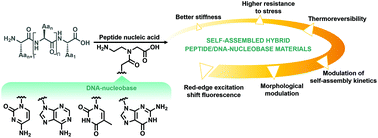Improving and fine-tuning the properties of peptide-based hydrogels via incorporation of peptide nucleic acids†
Abstract
Peptide self-assemblies have attracted intense research interest over the last few decades thanks to their implications in key biological processes (e.g., amyloid formation) and their use in biotechnological and (bio)material fields. In particular, peptide-based hydrogels have been highly considered as high potential supramolecular materials in the biomedical domain and open new horizons in terms of applications. To further understand their self-assembly mechanisms and to optimize their properties, several strategies have been proposed with the modification of the constituting amino acid chains via, per se, the introduction of D-amino acids, halogenated amino acids, pseudopeptide bonds, or other chemical moieties. In this context, we report herein on the incorporation of DNA-nucleobases into their peptide nucleic acid (PNA) forms to develop a new series of hybrid nucleopeptides. Thus, depending on the nature of the nucleobase (i.e., thymine, cytosine, adenine or guanine), the physicochemical and mechanical properties of the resulting hydrogels can be significantly improved and fine-tuned with, for instance, drastic enhancements of both the gel stiffness (up to 70-fold) and the gel resistance to external stress (up to 40-fold), and the generation of both thermo-reversible and uncommon red-edge excitation shift (REES) properties. To decipher the actual role of each PNA moiety in the self-assembly processes, the induced modifications from the molecular to the macroscopic scales are studied thanks to the multiscale approach based on a large panel of analytical techniques (i.e., rheology, NMR relaxometry, TEM, thioflavin T assays, FTIR, CD, fluorescence, NMR chemical shift index). Thus, such a strategy provides new opportunities to adapt and fit hydrogel properties to the intended ones and pushes back the limits of supramolecular materials.



 Please wait while we load your content...
Please wait while we load your content...